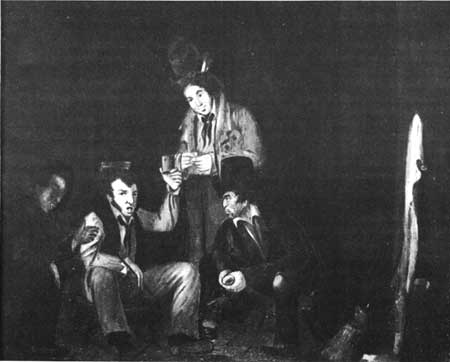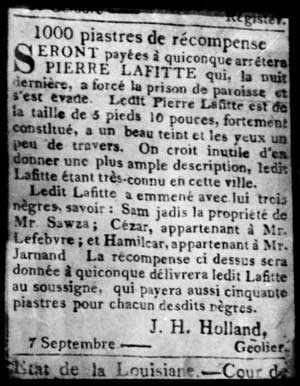|
CHALMETTE National Historical Park |
 |

W. C. C. Claiborne, Governor of Orleans Territory,
1803—12; Governor of the State of Louisiana, 1812-16;
Commander-in-Chief, Louisiana Militia, 1814-15.
Courtesy,
Louisiana National Guard, T. J. Harrison, State Military
Historian
Louisiana in 1814
Louisiana was founded by the French, and its early growth was under their rule. Then followed a period of Spanish domination. In 1803, it was French again briefly before becoming American as part of the Louisiana Purchase. Even under American rule, many French refugees from the wars in the West Indies and Europe kept New Orleans, Louisiana's chief city, predominately Latin. Also, the city had all the elements of a cosmopolitan seaport. Although Louisiana was admitted as a state in 1812, it still seemed like a foreign country to people from Kentucky or Tennessee.
W. C. C. Claiborne, a Virginian by birth, was Governor of Louisiana in 1814. As head of the militia, he could not find enough reliable troops to defend the state. Only a few regulars were stationed at New Orleans. Many planters, remembering the slave uprising of 1811, did not want to leave to defend the frontiers. In spite of all this, the spirit of the militia strengthened as the danger of British invasion came closer.
In the early years of "American domination" there was enmity between Americans and Creoles (white Louisianans of French or Spanish descent); however, Claiborne wrote Jackson that the majority of Creoles and Europeans in New Orleans were loyal, but that many favored Spain or England.
In this connection, the British believed that the inhabitants of Barataria, who lived on the Louisiana coast about 50 miles south of new Orleans, would aid them in their conquest of Louisiana. The Baratarians admitted smuggling and privateering, and were accused of piracy. They were led by the mysterious Lafitte brothers, Jean and Pierre, but Barataria existed before their arrival about 1810. After 1804, when the importation of slaves became illegal in Orleans territory, smuggling them in was another line of "business" for these privateers. In the year before the British invasion, the Baratarians were having more trouble than formerly with both State and Federal authorities.

This interesting sketch reputedly shows Louisiana
pirate leaders drinking in a cafe in New Orleans in 1812. From left to
right, the men are traditionally identified as Renato Beluche, Jean
Lafitte, Pierre Lafitte, and Dominique You.
Courtesy, Louisiana
State Museum.
On September 3, 1814, British officers appeared at Barataria and offered Jean Lafitte land in British North America, protection of his property and person, $30,000 in cash, and the rank of captain in their navy, if he would join them. Lafitte asked for time to consider their offer, and promptly wrote to the Governor and to a member of the legislature. He told them of the British offer, enclosed documents to prove his story, and offered to help the Americans in return for a pardon for himself and his men.
These letters were received in New Orleans on September 5. On advice from his military committee, Governor Claiborne declined Lafitte's offer, but he wrote soon after that the privateers might become useful to the United States. Pierre Lafitte, who had been arrested and jailed in New Orleans, escaped about this time, possibly with help from those in high places.
Barataria was destroyed by United States forces under Col. G. T. Ross and Commodore D. T. Patterson, between September 16 and 19. The Baratarians fled to the swamps rather than resist. Their avoidance of conflict, following Jean Lafitte's offer of help, was making some impression on the American authorities. On October 30, Claiborne wrote to the United States Attorney General, recommending clemency for the smugglers. The Americans and Baratarians were gradually coming together as the British prepared their grand assault.

This handbill tells its own story about one of the
Baratarian leaders. It also shows that French was the language of New
Orleans in 1814.
Translation.
$1,000 Reward
WILL BE paid to whomever will arrest PIERRE LAFITTE, who last night forced the Parish Prison and escaped from it. Said Pierre Lafitte is 5 feet 10 inches tall, strongly built, has a light complexion and is somewhat cross-eyed. Further description is believed unnecessary, the said Lafitte being well known in this city.
The said Lafitte took with him three negroes, to wit: Sam, formerly the property of Mr. Sawza; Caesar, belonging to Mr. Lefebvre; and Hamilcar, belonging to Mr. Jarnand. The above reward will be given to whomever delivers the said Lafitte to the undersigned, who will also pay $50 for each of the aforesaid negroes.
J. H. Holland
JailerSeptember 7.

(click on image for an enlargement in a new window)

|
|
Last Modified: Mon, Dec 2 2002 10:00:00 am PDT |


